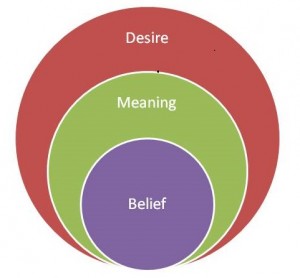The relationship between desire, meaning and belief is central to understanding certain key ideas in Middle Way Philosophy that might otherwise be puzzling: for example, how one could have an appreciation of the meaning of a symbol like God whilst clearly avoiding belief in God, or how the meaning of words unavoidably depends on the energy that we apply to them, so that the safety instructions at the beginning of a flight can be formally comprehensible but also largely meaningless. 
The stacked venn diagram here illustrates the relationship. All beliefs are meanings, but not vice-versa, and all meanings are desires, but not vice-versa. Desires are the basic constituents of all these mental processes. This way of understanding them reverses the widespread approach of thinking of belief first, and making our concepts of desire and meaning fit our concepts of belief.
This may make more sense with some definitions. Such definitions are never final, but they aid clarity:
- Desire is any energy, drive or motive that actually or potentially creates mental or physical activity, conscious or unconscious
- Meaning is the habitual attachment of desire to a symbol (for more on meaning see the embodied meaning page)
- Belief is a habitual motive of commitment to a particular pattern of meaningful symbols that can be interpreted as representations
As you can see here, meaning is desire associated with symbols, whilst belief takes those symbols and forms them into accounts of what we think the world is like. We can be committed to those accounts to varying degrees, from a provisional theory or hypothesis to a rigid metaphysical belief.
Another way of understanding this progression between the three types of process is in terms of neural connections in the brain. The desire response is a very basic type of neural connection. For example, a sexual response needs little deliberate cultivation: it is ‘hard-wired’ into our brains. The associations that create a certain energy-response to symbols, however, need to be developed through active experience as we explore the world as young children. For example, as a child understands the meaning of the word ‘in’ in relation to boxes, houses, fields etc, a new neural connection is created and gradually strengthened. Beliefs consist in more complex sets of neural connections that arise in response to sets of symbols that represent the world for us. These could be the connections that lead me to believe that it is raining outside (in response to the noise of dripping and drumming), or that a tin of beans contains edible stuff, or that Ulan Bator is the capital of Mongolia. These connections are not just those that fit the symbols together, but also those that commit me to them as representations of how I think things are. At each level the symbols become more complex and more reliant on experience.
The more common pattern, in metaphysically-dominated thinking, is to understand meaning in terms of belief. In this view, meaning has to be propositional and explicit, only occurring in sentences. The huge proportion of our mental processes that occur unconsciously are excluded from either meaning or belief, and what makes a symbol meaningful is assumed to be its capacity to form a basis of belief. But much of what we find meaningful has nothing to do with belief: mythical beings, stories, works of art, and music are all examples of things that have a significance for us regardless of what we believe about them.
Some of that meaning, as Jung pointed out, is archetypal: it rouses desires within a basic psychic structure that we all share rather than from specific external experiences. For example, the Shadow archetype depends on an association with the rejected psyche beyond the ego, and we project this archetype onto people whom we regard as evil. The meaning of an archetype has nothing to do with our beliefs, but involves a much more basic pattern of meaningfulness than comes with our embodied existence. Fear of the devil resonates in our bodies whether or not we “believe in” the devil.
The vast majority of our desires, meanings and beliefs are unconscious or pre-conscious. They consist of successive layers of association and response with increasing complexity, building up to conscious representations as the tip of the iceberg rather than the base. Because all three layers are based on energies, those energies can be opposed to one another or they can be integrated. That means that not only desires, but also meanings and beliefs, can be integrated. We need to develop integration of all three inter-dependent types in order to make lasting progress with integration in general.

The Venn diagram is – for me – a powerful visual aid to understanding the relationship of desire to meaning, and meaning to belief. The ‘upwards dynamic’ that I think is implied in these concepts being built up from the ‘lower’ to the ‘upper’ level suggests the emergence of meaning and belief (on the one hand) as part of the unfolding of the psyche, the unfolding of the ‘self’ or ‘selves’, as we grow and mature.
It also seems to imply the ‘descent’ that needs – perhaps – to be made, if we are to find the source of our beliefs, the origins of our meanings, in the embodiment of our desires, including those that are thwarted, suppressed, or unacknowledged.
This teaching speaks to me quite directly. References to embodied meaning, ‘felt sense’, and the practical methods of Eugene Gendlin have helped these ideas coalesce and come alive for me, but I need to assimilate the new learning, and wait for more inner guidance so I can begin to integrate it into my life and embark on a new way of being.